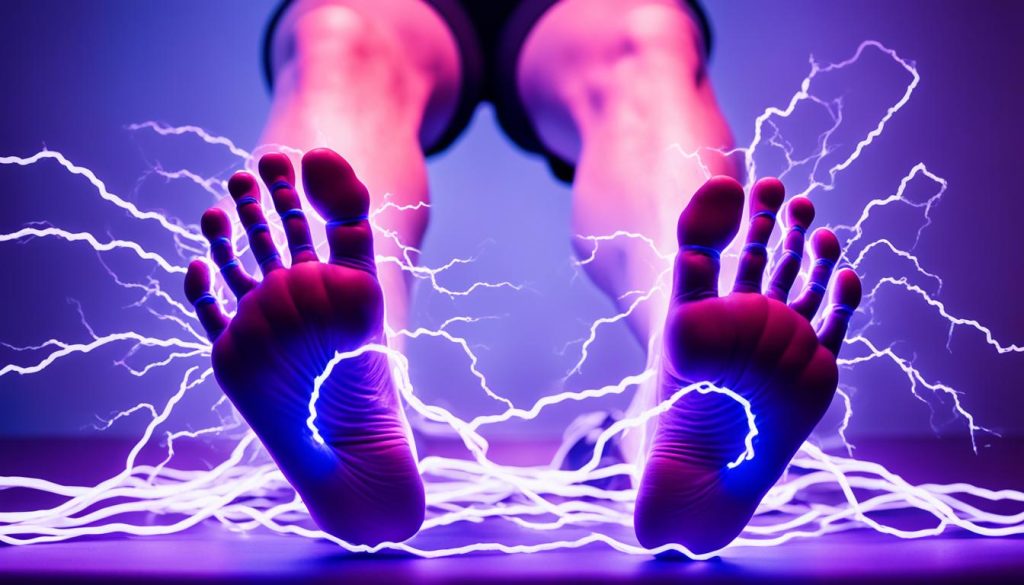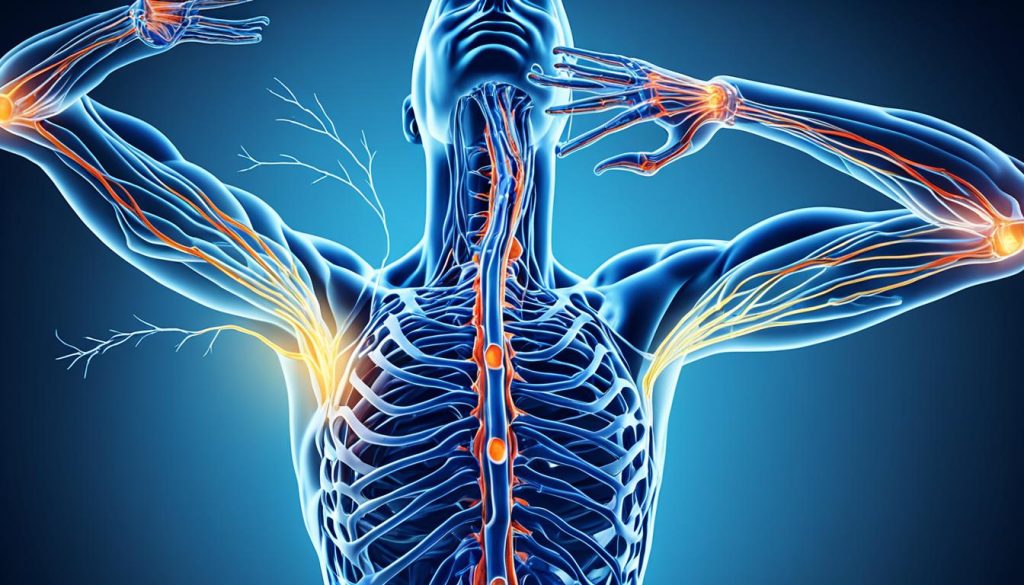Numbness and tingling in the arms and hands can be caused by various factors. These sensations, also known as paresthesia, can manifest as pricks, numbness, or burning under the skin. While some cases of tingling can be temporary and harmless, others can be severe, chronic, or accompanied by other symptoms.
The most common cause of tingling in the hands and feet is peripheral neuropathy, which results from nerve damage. Conditions such as diabetes, vitamin deficiencies, nerve compression (such as carpal tunnel syndrome), autoimmune diseases, infections, and genetic disorders can also contribute to numbness and tingling in the arms and hands.
It is important to seek medical help if these symptoms persist, as early detection and treatment can prevent long-term complications.
Peripheral Neuropathy: The Most Common Cause of Tingling in Hands and Feet
Peripheral neuropathy is a condition that affects the peripheral nerves, which are responsible for transmitting signals between the body and the central nervous system. It is the leading cause of tingling, numbness, and other abnormal sensations in the hands and feet.
The main cause of peripheral neuropathy is nerve damage, which can occur due to various factors. Among these, diabetes is a major contributor, accounting for approximately 30% of peripheral neuropathy cases. When blood sugar levels are poorly controlled over time, they can damage the nerves, leading to tingling sensations.

In addition to diabetes, there are other potential causes of peripheral neuropathy. Vitamin deficiencies, particularly of vitamins B1, B6, B12, and E, can affect nerve health and function. Autoimmune diseases, such as rheumatoid arthritis and lupus, can also damage the nerves and cause tingling in the hands and feet.
Exposure to certain toxins, such as heavy metals like lead and mercury, as well as some medications, can contribute to nerve damage and peripheral neuropathy. Additionally, infections, including Lyme disease and HIV, can affect the peripheral nerves and lead to tingling sensations.
It is estimated that over 20 million Americans, particularly older adults, have peripheral neuropathy. Early diagnosis and management of the underlying cause are crucial in preventing further nerve damage and complications. Treatment options for peripheral neuropathy focus on alleviating symptoms, addressing the underlying cause, and improving quality of life.
Prevention and Management of Peripheral Neuropathy:
- Maintain stable blood sugar levels if you have diabetes.
- Eat a balanced diet rich in vitamins and minerals.
- Avoid exposure to toxins and chemicals.
- Take precautions to prevent infections.
- Engage in regular exercise to improve circulation.
- Quit smoking and limit alcohol consumption.
- Wear comfortable shoes that provide proper support.
If you experience persistent tingling or numbness in your hands and feet, it is important to consult with a healthcare professional for an accurate diagnosis and appropriate treatment. Managing peripheral neuropathy effectively can help improve symptoms, prevent further nerve damage, and enhance overall well-being.
Common Conditions That Cause Numbness and Tingling in Hands and Arms
Various conditions can lead to numbness and tingling in the hands and arms. It is essential to understand these conditions as they can significantly impact daily activities and quality of life. Some common conditions that cause numbness and tingling sensations include:
Carpal Tunnel Syndrome
Carpal tunnel syndrome occurs when the median nerve in the wrist is compressed. This compression can result from repetitive motions, underlying health conditions, or trauma to the wrist. The symptoms of carpal tunnel syndrome include tingling or numbness in the fingers and hands, weakness, and pain. It is often seen in individuals who perform repetitive tasks or use vibrating tools regularly.
Ulnar Nerve Entrapment Syndrome
Ulnar nerve entrapment syndrome affects the ulnar nerve, which is responsible for sensation in the little finger, part of the ring finger, and the ulnar side of the palm. It occurs when there is pressure or compression on the nerve, leading to numbness, tingling, and weakness in the affected areas. This condition can be caused by various factors, such as repetitive motions, prolonged pressure on the elbow, or injury.
Radial Nerve Palsy
Radial nerve palsy can occur when there is pressure on the radial nerve at the bottom of the arm. It is often caused by sleeping with the arm in an awkward position or direct trauma to the nerve. The symptoms include numbness, tingling, and weakness in the forearm, wrist, and hand. In some cases, individuals may also experience difficulty extending the wrist or fingers.
These conditions affecting the hands and arms can be disruptive and interfere with daily activities. It is important to seek medical attention for proper diagnosis and treatment. Early intervention can help alleviate symptoms and prevent further complications.

What Causes Numbness and Tingling in Arms and Hands?
Tingling and numbness in the feet and legs can be attributed to different conditions. The following are some of the underlying causes:
Peroneal Nerve Palsy (Fibular Neuropathy)
Tingling or numbness in the outside of the leg or the top of the foot
Peroneal nerve palsy, also known as fibular neuropathy, occurs when the nerve that travels down the leg is damaged or compressed. This can lead to symptoms such as tingling or numbness in the outer part of the leg or the top of the foot. Trauma, pressure, or underlying diseases can cause this condition to occur.
Tarsal Tunnel Syndrome
Tingling or numbness along the inside of the ankle
Tarsal tunnel syndrome is similar to carpal tunnel syndrome but affects the foot. It occurs when there is compression of the tibial nerve in the tarsal tunnel, leading to tingling or numbness along the inside of the ankle. This condition can result from various causes, including trauma, pressure, or other underlying factors.
Sciatica
Tingling in the legs
Sciatica is often caused by herniated discs in the lower back that compress the nerves, including the sciatic nerve. This compression can lead to tingling or numbness in the legs. Trauma, pressure, or underlying conditions can contribute to the development of sciatica.
Identifying the underlying cause of tingling in the feet and legs is crucial in determining the appropriate treatment and management strategies. It is recommended to consult with a healthcare professional for an accurate diagnosis and personalized care plan.
Other Factors That Contribute to Numbness and Tingling in Arms and Hands
Numbness and tingling in both the hands and arms can be caused by various factors. Let’s take a closer look at some of these contributing factors:
Anxiety and Tingling
Anxiety can manifest in physical symptoms, including tingling sensations in the hands, fingers, feet, toes, and even around the mouth and face. It is believed that anxiety activates the body’s stress response, leading to changes in blood flow and nerve sensitivity, resulting in tingling sensations.
Fibromyalgia and Tingling
Fibromyalgia, a chronic pain disorder that affects the muscles and soft tissues, can also cause tingling in both the hands and arms. This condition is characterized by widespread pain, fatigue, and tender points in various parts of the body. The exact cause of fibromyalgia is unknown, but it is believed to involve abnormalities in the way the brain and spinal cord process pain signals.
Cervical Spondylosis
Cervical spondylosis, a condition that affects the neck and can lead to degeneration of the spinal discs, can result in numbness and tingling in the arms and legs. When the spinal discs deteriorate, they can put pressure on the spinal nerves, causing symptoms such as tingling, weakness, and pain.
Systemic Diseases and Tingling
Certain systemic diseases, such as kidney disorders, liver disease, and hormonal imbalances, can contribute to numbness and tingling sensations in the arms and hands. These conditions can affect nerve function and lead to sensory abnormalities.
Vitamin Deficiencies and Numbness
Vitamin deficiencies, particularly of vitamins B1, B6, B12, and E, can result in nerve damage and subsequent numbness in the hands and feet. These vitamins play a crucial role in maintaining nerve health, and insufficient levels can lead to peripheral neuropathy, a condition that affects the nerves outside the brain and spinal cord.
Understanding these various factors that contribute to numbness and tingling in the arms and hands can help individuals identify potential underlying causes and seek appropriate medical attention. It is important to consult with a healthcare professional for an accurate diagnosis and personalized treatment plan.

Conclusion
In conclusion, numbness and tingling in the arms and hands can have various causes, including peripheral neuropathy, nerve compression, hormonal imbalances, autoimmune diseases, and vitamin deficiencies. These symptoms should not be ignored and require medical attention if they persist. Early diagnosis and appropriate treatment are essential for preventing further nerve damage and improving overall quality of life.
Managing and preventing numbness and tingling in the arms and hands can also be achieved through lifestyle modifications. Maintaining a healthy weight, eating a balanced diet, and avoiding excessive alcohol consumption can contribute to managing these symptoms. These lifestyle changes can support overall nerve health and reduce the risk of developing or exacerbating existing conditions that lead to numbness and tingling.
If you are experiencing persistent numbness and tingling in your arms and hands, it is crucial to consult with a healthcare professional who can evaluate your symptoms, conduct appropriate diagnostic tests, and recommend an individualized treatment plan. Do not disregard these symptoms as they may be indicative of an underlying condition that requires intervention. Taking proactive steps to address numbness and tingling in the arms and hands can lead to better outcomes and an improved quality of life.




